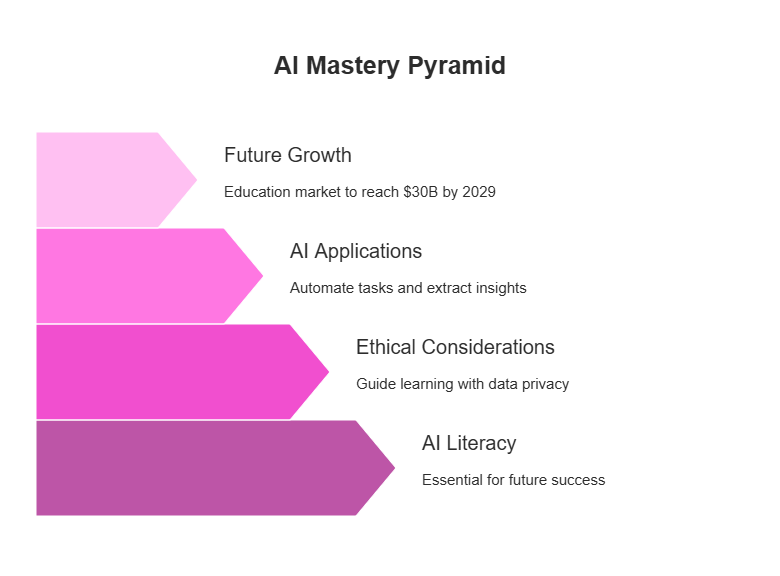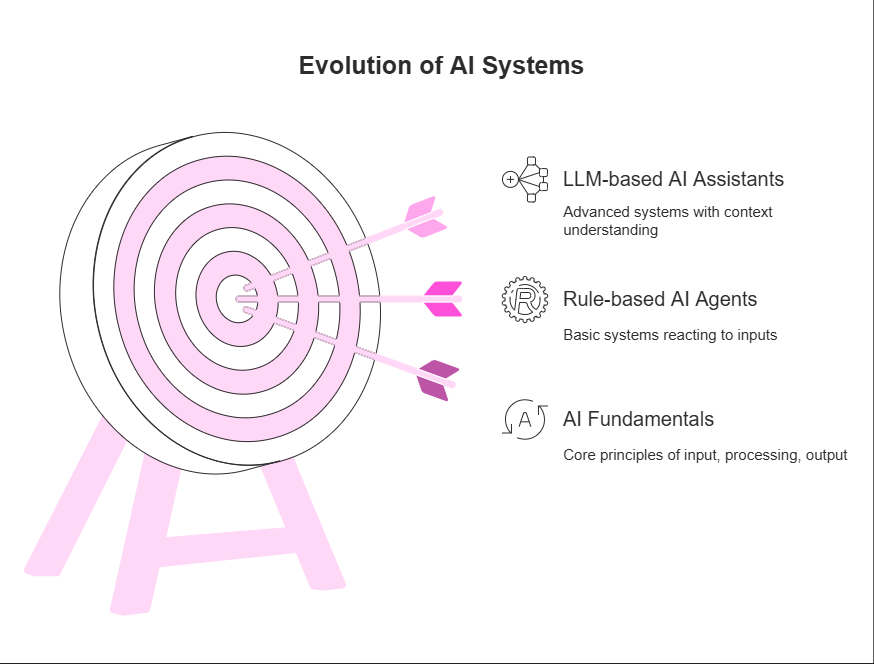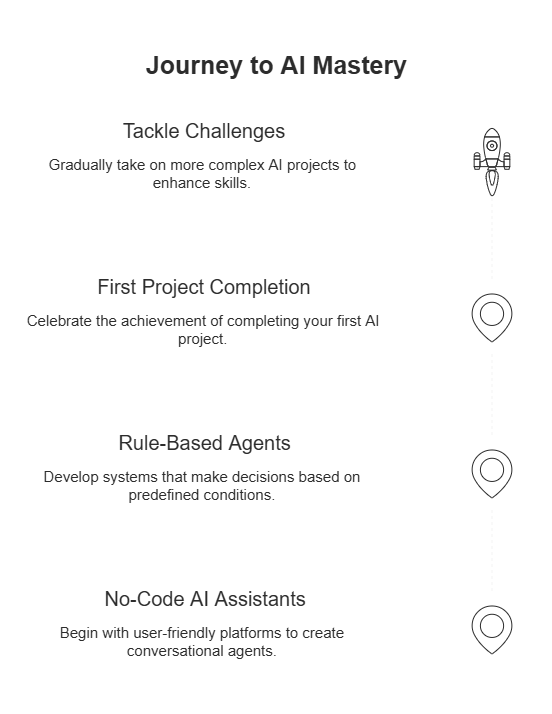This guide breaks down artificial intelligence fundamentals for newcomers without technical backgrounds. AI systems perform tasks that typically need human intelligence, from recognizing patterns to making decisions.
Each section builds your knowledge step by step, making complex ideas accessible without overwhelming you with technical details. Let’s jump into the world of artificial intelligence together.
What Artificial Intelligence Means for Beginners
Artificial intelligence represents computer systems that perform tasks typically requiring human intelligence. These systems recognize patterns, solve problems, and make decisions without constant human input. AI for beginners often seems intimidating, but the basic concept is actually quite straightforward.
Think of AI as the big umbrella term covering various technologies. As detailed in our AI vs ML breakdown, machine learning exists as a subset where computers learn from data without explicit programming. Deep learning takes this a step further. It uses neural networks inspired by the human brain to process complex information. In a way, if AI represents the entire forest, machine learning would be a group of trees, and deep learning would be a specific species.
AI comes in two main types: narrow and general. Narrow AI excels at specific tasks—like virtual assistants recognizing voices or recommendation systems suggesting movies. General AI, which would match human intelligence across all domains, remains largely theoretical. The tools you encounter today are almost exclusively narrow AI, designed for specific purposes.
The evolution of these technologies has been pretty remarkable since the 1950s. From simple rule-based systems to today’s sophisticated algorithms powering self-driving cars and medical diagnostics, AI capabilities have grown more accessible.
Why Embrace AI Today and What You Can Achieve
AI adoption rates have soared across industries, transforming how we live and work. Recent data shows that 78% of business leaders have integrated AI into at least one function. Education systems are changing too, with student surveys revealing that 92% of students now use AI tools—up from 66% last year. This rapid shift makes AI literacy almost essential for future success.
The education AI market will likely reach $30 billion by 2029, in fact. As beginners explore these tools, ethical questions about data privacy and algorithmic bias should guide your learning journey from day one.
What can you achieve with AI? Many people focus on limitations rather than possibilities. From automating routine tasks to extracting insights from complex data, AI applications offer advantages in virtually every field. Start small, experiment often, and build knowledge gradually.

Essential Foundations Every AI Beginner Should Know
Grasping a few core concepts gives you solid footing in the AI world. Let’s break down three learning approaches that power most artificial intelligence systems today.
Supervised learning resembles a student with a helpful teacher. Algorithms learn from labeled examples—picture sorting photos already tagged “dog” or “cat.” After training with enough examples, systems identify new images they’ve never encountered. My team built spam filters this way, training models to distinguish between legitimate emails and unwanted messages.
Unsupervised learning, on the contrary, discovers patterns without any labels. Consider grouping customer data without knowing categories beforehand—you might naturally find segments based on purchasing habits or demographics.
Reinforcement learning works through rewards and penalties. Algorithms learn by interacting with environments and receiving feedback on actions taken. This approach helped machines master complex games such as chess and Go.
The math foundations supporting these approaches aren’t as intimidating as many newcomers fear. Basic statistics helps understand data patterns. Linear algebra allows working with information tables. Calculus finds optimal solutions to complex problems.
Economic stakes make learning these foundations worthwhile. According to recent research, AI adoption in businesses has reached 77% of companies using or exploring AI technologies. Projections show artificial intelligence could contribute $15.7 trillion to the global economy by 2030.
This growth creates opportunities across industries—not just for programmers but for anyone who understands how to apply key AI concepts to real-world challenges.
Do You Need Programming to Start Learning AI?
Many believe you need advanced coding skills to begin with AI. Actually, this myth prevents countless people from exploring this exciting field. Beginners often enter the AI world without writing any code, while programming knowledge simply expands your capabilities.
No-code platforms have, in a way, democratized access to AI technology.
For those interested in coding, Python remains the top choice due to its readable syntax. Beginners should start with Python basics before exploring specialized frameworks, as outlined in this tech stack advice. This approach offers deeper customization but requires more time investment.
Your goals determine which path works best. No-code platforms provide the fastest entry point for understanding AI fundamentals. Learning Python creates a solid foundation that grows with your skills if you’re seeking career opportunities in AI development.
Popular AI Tools and Platforms for Beginners
Ready to start experimenting with AI? Today’s tools make jumping into artificial intelligence easier than ever before. Beginners can now access powerful capabilities without feeling overwhelmed by technical complexity.
No-code platforms have transformed how people access AI technology. Several options allow anyone to create applications without coding knowledge. Cubeo AI offers impressive GPT-4o integration alongside a Web Scraper for competitive analysis. Our LinkedIn DM Generator crafts personalized messages from profile URLs. These tools attracted 400 new users and earned 370 Product Hunt upvotes in just one month. Such popularity demonstrates their value to newcomers in the field.
For those comfortable with basic programming, beginner-friendly libraries offer different entry points:
- Scikit-learn serves as your friendly companion through machine learning basics. It handles classification, regression, and clustering tasks efficiently.
- TensorFlow provides more power but requires additional learning time. Its documentation and community support make the effort worthwhile.
- PyTorch attracts users with its intuitive design. Many researchers prefer this option for experimental projects.
When selecting tools, consider your specific needs. No-code platforms typically offer subscription models ($20-100/monthly) with free tiers available. In contrast, coding libraries cost nothing but require learning investment. The main trade-off involves immediate results versus customization options.
Exploring AI Assistants and Agents Today
AI agents range from basic rule-followers to complex conversational systems. This spectrum helps newcomers grasp current capabilities and future potential of artificial intelligence.
Basic AI systems start with what experts call reflex agents. Learn what a Reflex AI Agent is – these straightforward systems react instantly to inputs without memory of previous states. They sense surroundings, check rules, act, then repeat. Smart thermostats operate on this principle. They adjust temperature based on simple conditions without complex reasoning.
The difference between these basic systems and modern LLM-based assistants is remarkable. While rule-based agents follow fixed patterns, today’s AI assistants use language models to understand context and generate human-like responses. They remember conversation history, adapt to preferences, and perform various tasks without explicit programming.
We’ve quickly advanced from basic if-else logic to systems capable of writing poetry, debugging code, or explaining complex physics. For beginners, starting with rule-based agents provides a foundation to understand AI fundamentals before exploring advanced applications. The core principles remain similar – input, processing, output – but the complexity grows exponentially.

AI in Action Across Different Industries
Predictive analytics tools in healthcare now forecast patient risks with remarkable accuracy. In some respects, these systems identify subtle patterns in vital signs that human clinicians might miss.
Financial systems analyze thousands of transactions per second to detect fraud. A national bank actually implemented an AI-based behavioral analytics platform last year. Their results showed a 70% reduction in credit card fraud while decreasing false alerts by 80%. According to AI adoption rates among companies, nearly 83% of businesses now prioritize AI in strategic planning.
Beyond individual companies, AI creates millions of new jobs across different sectors.
Curious about building more sophisticated AI systems? Retrieval-Augmented Generation (RAG) combines reasoning capabilities with real-time data retrieval. This approach significantly improves accuracy for specialized applications. Learn more about implementing RAG in your projects through this Retrieval-Augmented Generation guide.
Hands-on Learning with Simple AI Projects
Practical experience strengthens theoretical knowledge. Here are three beginner-friendly AI projects to boost your confidence.
No-code AI assistants offer an excellent starting point. Platforms with prebuilt workflows allow anyone to create functional conversational agents.
Rule-based agents provide another approachable entry point. You might remember our thermostat example from earlier. These systems make decisions based on predefined conditions.
Completing your first project matters more than its complexity. Start small, celebrate progress, and gradually tackle more challenging ideas.

Curated Resources to Guide Your AI Journey
Finding quality learning materials can be pretty overwhelming due to countless options available.Here’s a collection of resources that can actually accelerate your AI education:
Online courses provide a comprehensive path for structured learning. “AI For Everyone” by Andrew Ng on Coursera stands out as an excellent starting point with no technical prerequisites. If you’re ready to explore further, this AI learning roadmap systematically builds foundational skills. In a way, following such guidance becomes crucial as the AI market heads toward $243.72 billion by the end of 2025, creating abundant opportunities for skilled practitioners.
Several books deserve space on your shelf too. Russell and Norvig’s “Artificial Intelligence: A Modern Approach” remains the definitive textbook, while Chip Huyen’s “AI Engineering” offers practical system design insights. For a gentler introduction, Janelle Shane’s “You Look Like a Thing and I Love You” explains AI concepts with humor and accessibility.
The Future of AI and Career Opportunities
AI careers show remarkable promise for the next decade. The global AI sector will grow at a 37% compound annual growth rate. This expansion will create about 133 million new jobs by 2030, according to projected AI market growth data. These aren’t just replacement positions but entirely new career categories that didn’t exist years ago.
Machine learning engineering stands at the forefront of in-demand skills. These professionals earn between $101,000 and $257,000 annually. They design algorithms that help systems learn from data with minimal human input. Natural Language Processing specialists also enjoy high demand. They build foundations for chatbots, translation systems, and sentiment analyzers.
Data science provides the backbone for AI advancement. Professionals in this field typically earn $95,000 to $100,000 yearly. Their skills in statistics and programming transform raw information into valuable insights.
Staying current requires ongoing education. Major events like MIT’s EmTechAI (May 2025) showcase cutting-edge research. For those who can’t attend in person, journals like Nature Machine Intelligence offer valuable insights.
FAQ
Which no-code AI tools are best for beginners?
Akkio, Teachable Machine, and Cubeo AI are top no-code AI tools ideal for beginners. These platforms provide user-friendly interfaces, enabling model building without needing to write code. Lobe AI, developed by Microsoft, offers an intuitive UI and pre-trained image recognition models. Teachable Machine provides an easy-to-use platform for creating predictive models quickly. Whether you’re a small business owner, a marketer, an HR professional, or just someone passionate about AI, Cubeo is designed to bring your ideas to life without the need for any coding skills.
How can I apply AI in my industry as a beginner?
To begin, start small by identifying inefficiencies and problems in your industry. Learning Python can help you understand AI basics. Focus on specific business problems and explore AI tools that offer solutions. Prioritize problems based on their impact and required resources.
What career paths are available in AI today?
Many career paths are available in the field, including data scientist, AI engineer, and machine learning researcher. Most AI roles require a bachelor’s degree in computer science or related fields. Advanced positions often need a master’s degree or a Ph.D. A data scientist leverages statistical analysis and machine learning to build predictive models.



